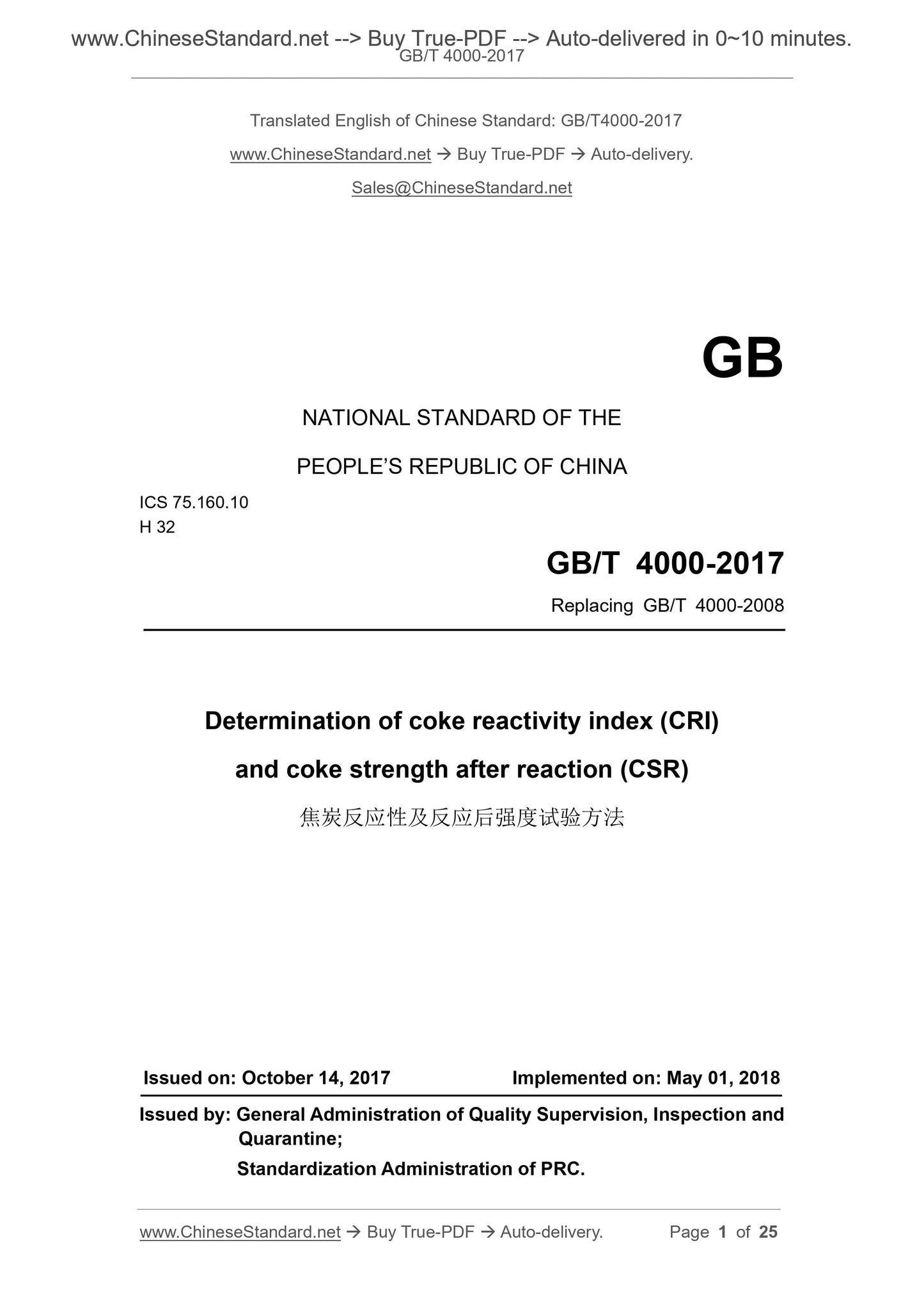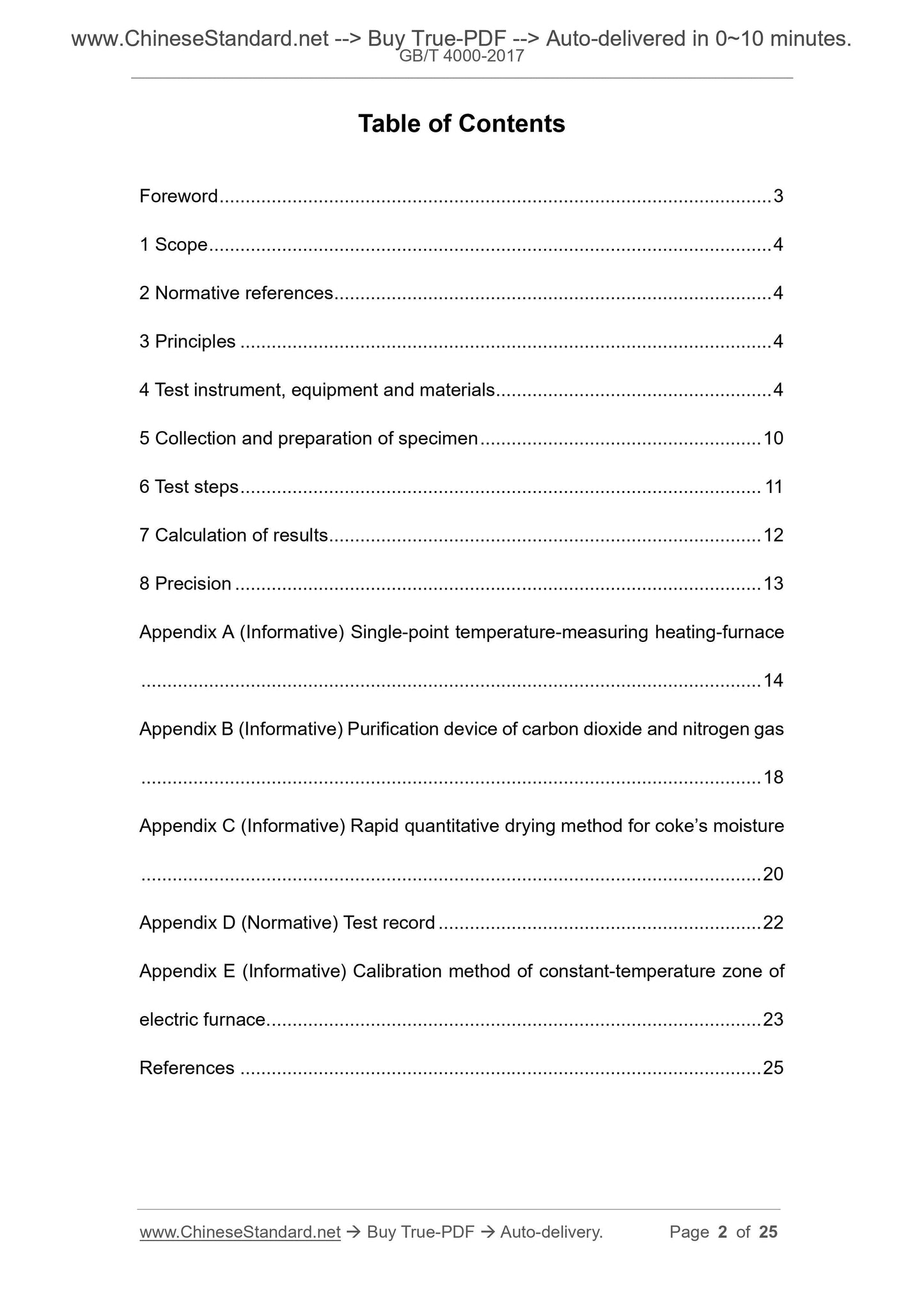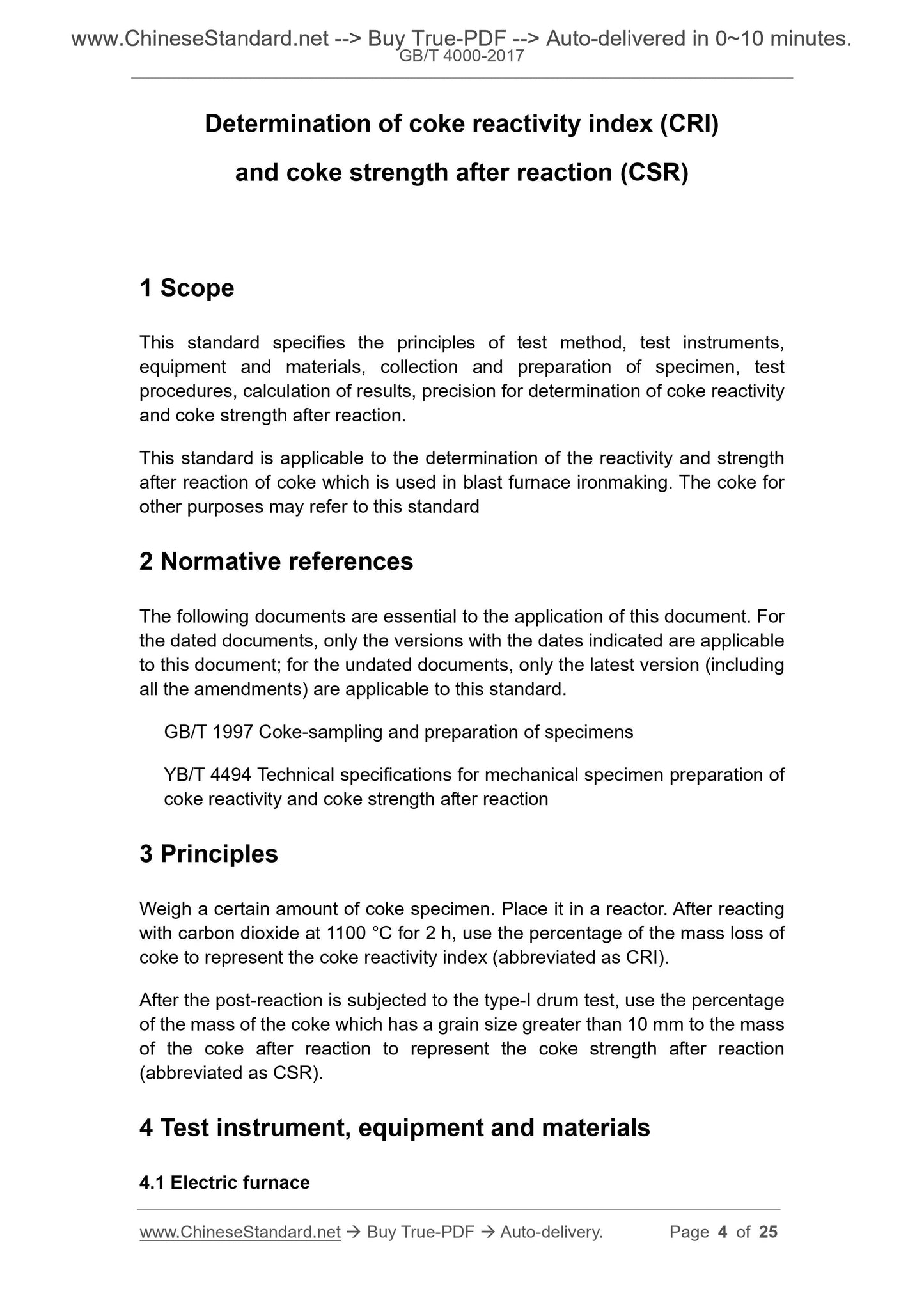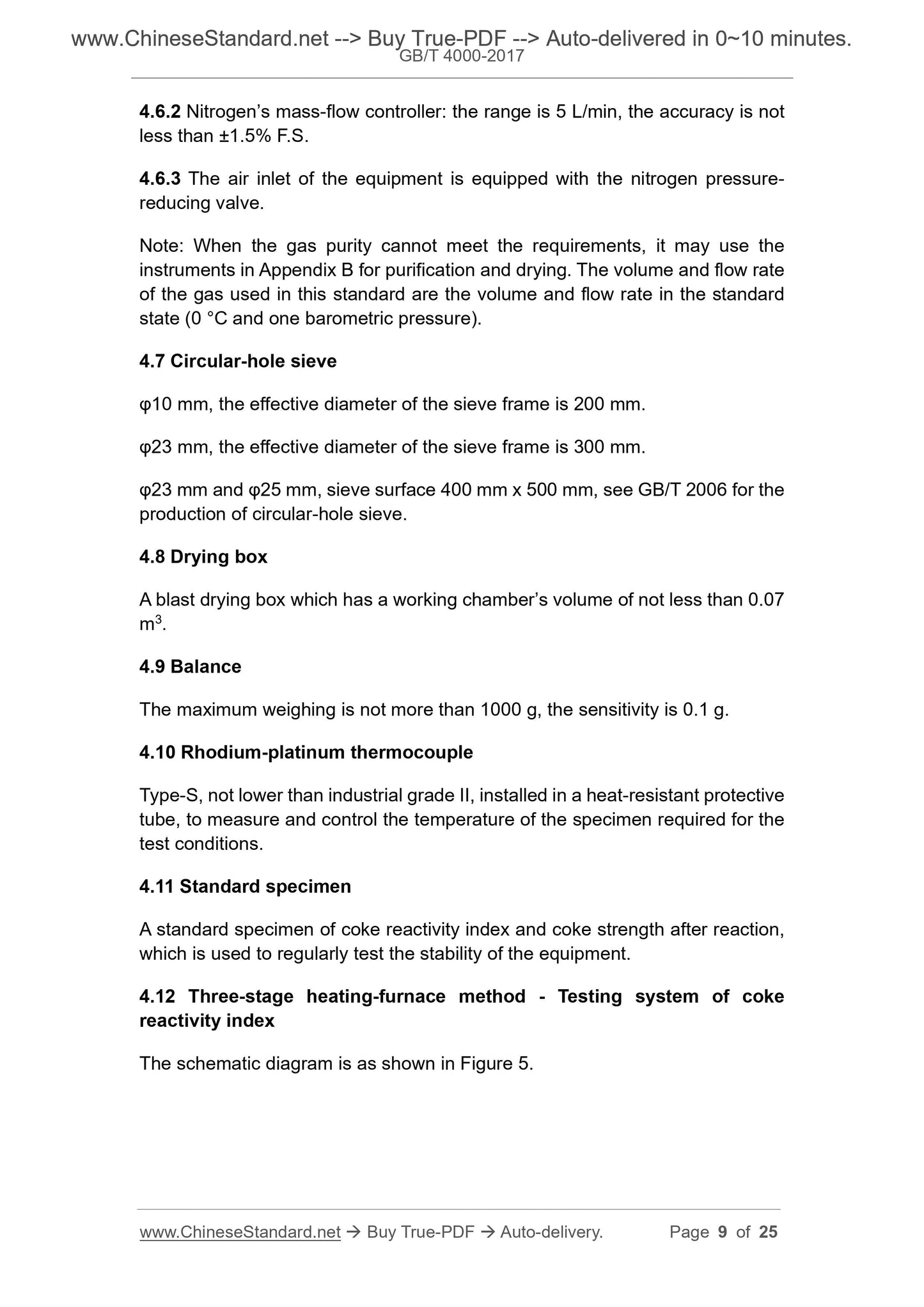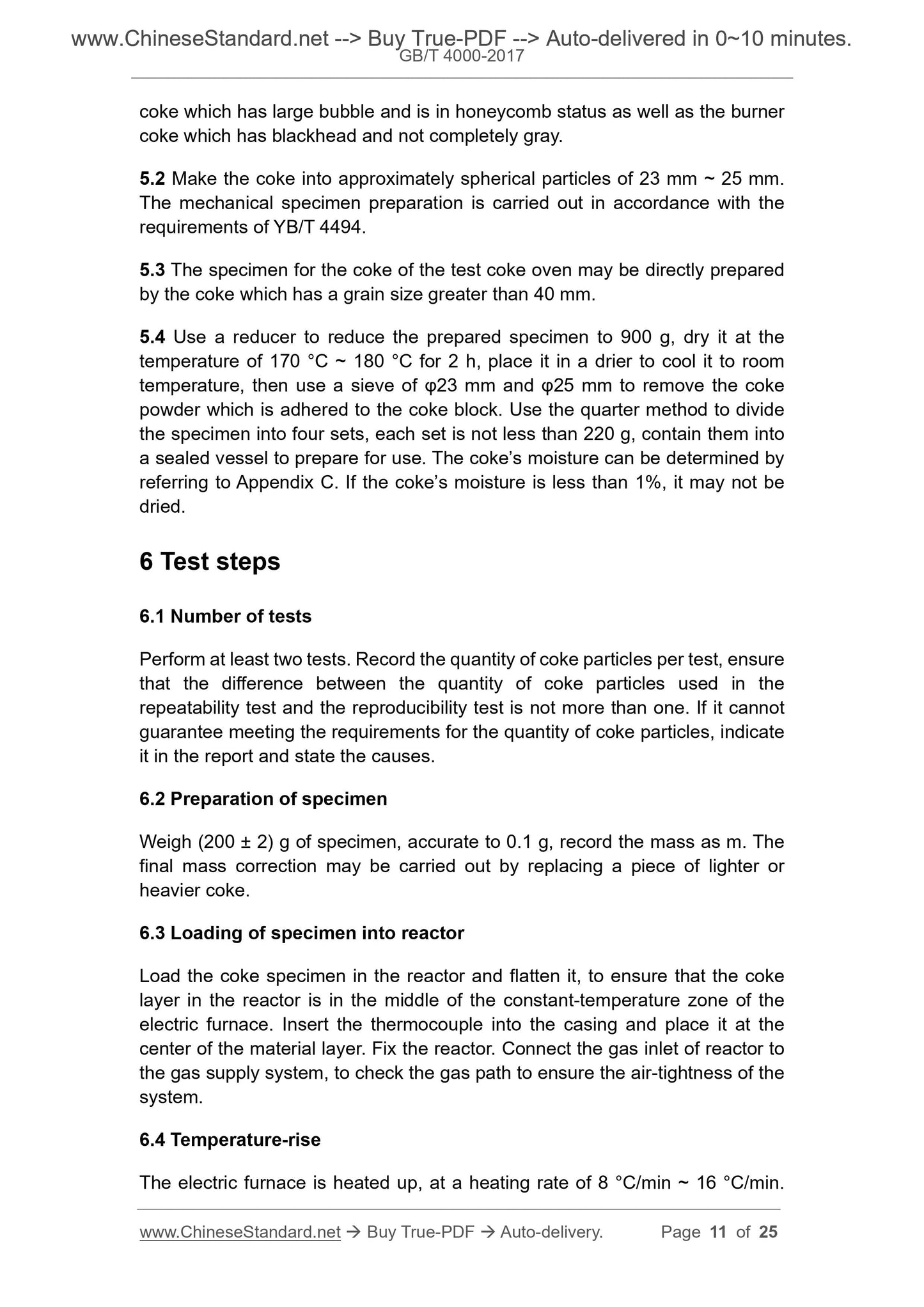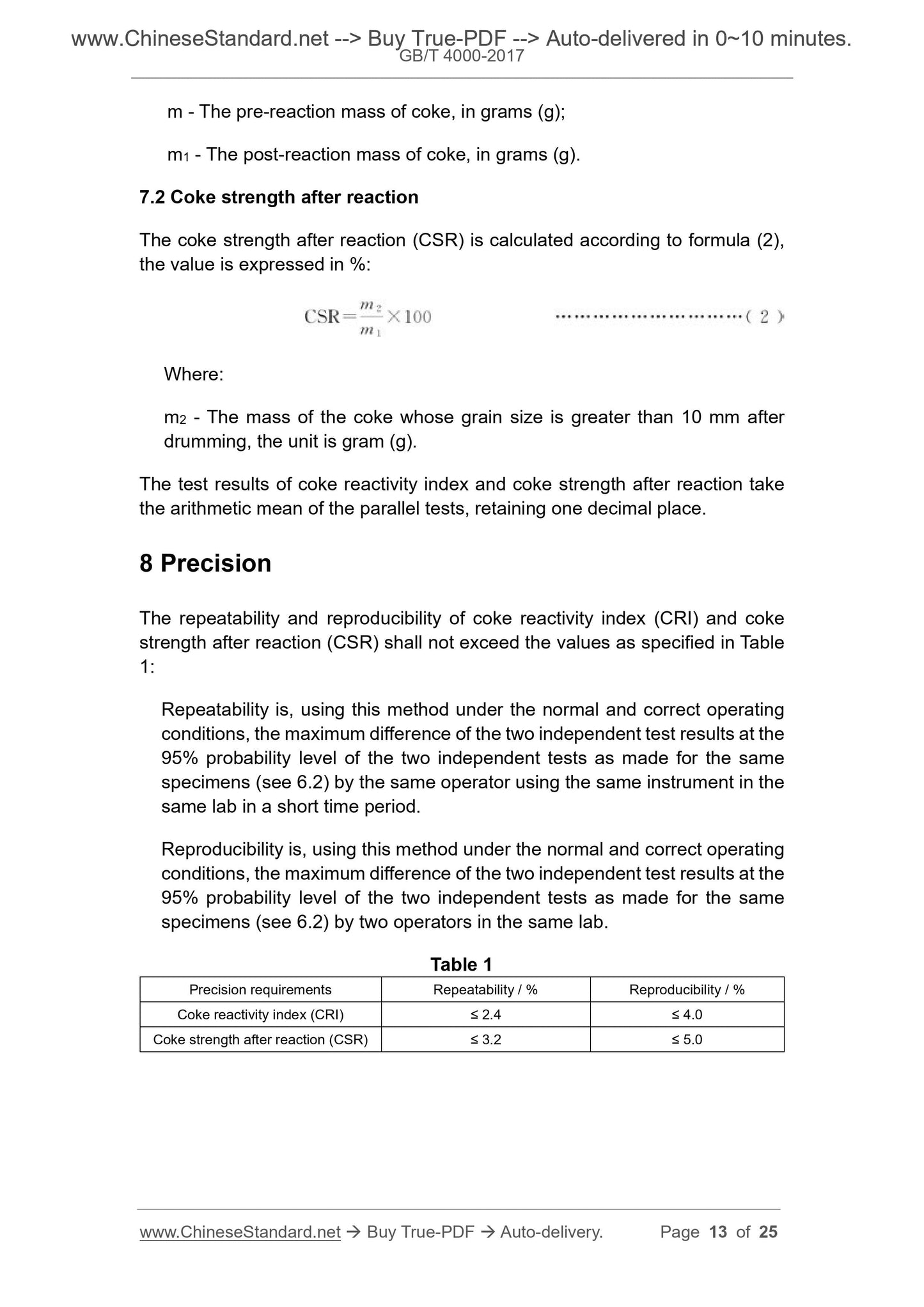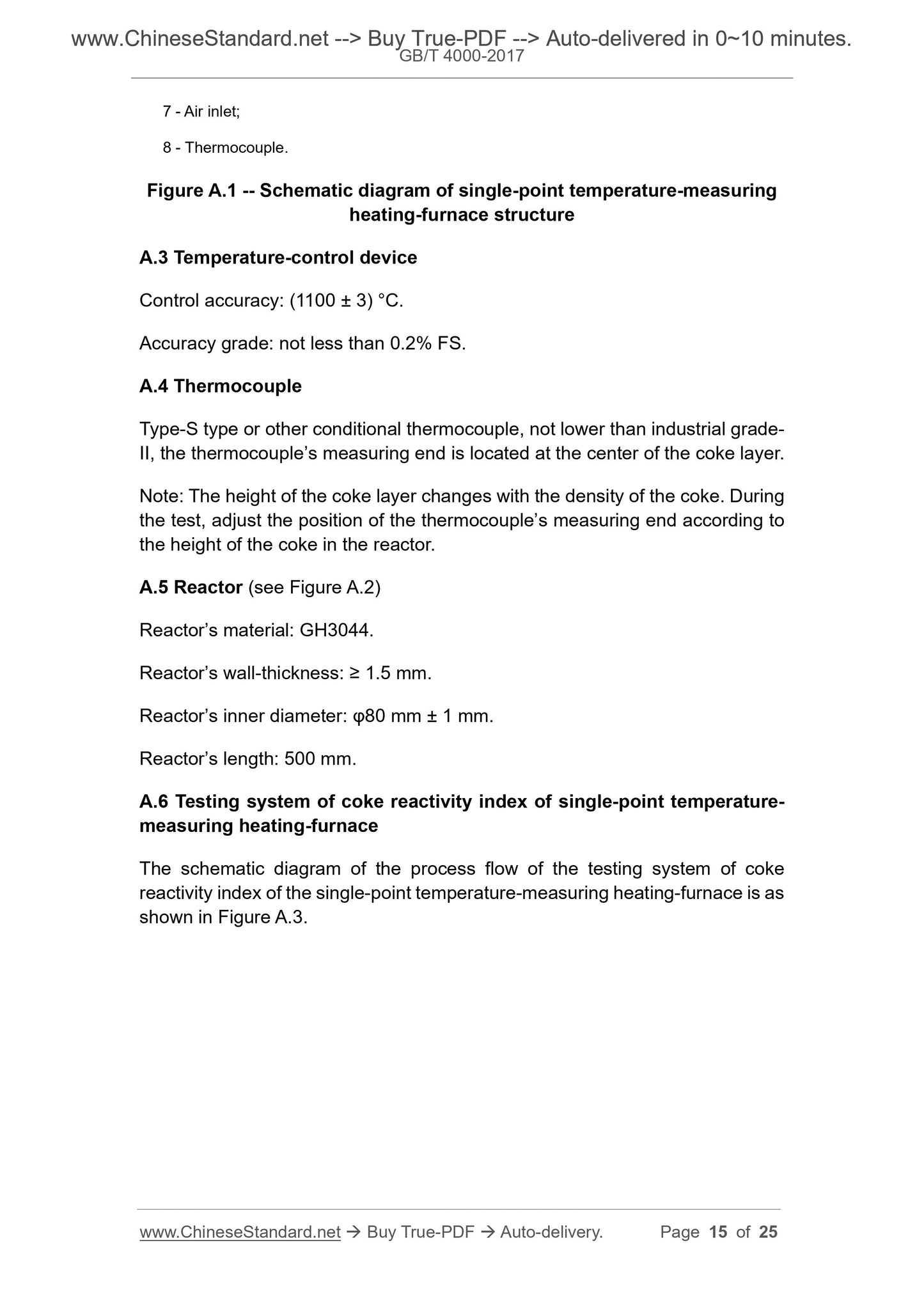1
/
of
7
PayPal, credit cards. Download editable-PDF and invoice in 1 second!
GB/T 4000-2017 English PDF (GBT4000-2017)
GB/T 4000-2017 English PDF (GBT4000-2017)
Regular price
$145.00 USD
Regular price
Sale price
$145.00 USD
Unit price
/
per
Shipping calculated at checkout.
Couldn't load pickup availability
Delivery: 3 seconds. Download true-PDF + Invoice.
Get QUOTATION in 1-minute: Click GB/T 4000-2017
Historical versions: GB/T 4000-2017
Preview True-PDF (Reload/Scroll if blank)
GB/T 4000-2017: Determination of coke reactivity index (CRI) and coke strength after reaction (CSR)
GB/T 4000-2017
GB
NATIONAL STANDARD OF THE
PEOPLE’S REPUBLIC OF CHINA
ICS 75.160.10
H 32
Replacing GB/T 4000-2008
Determination of coke reactivity index (CRI)
and coke strength after reaction (CSR)
ISSUED ON. OCTOBER 14, 2017
IMPLEMENTED ON. MAY 01, 2018
Issued by. General Administration of Quality Supervision, Inspection and
Quarantine;
Standardization Administration of PRC.
Table of Contents
Foreword ... 3
1 Scope ... 4
2 Normative references ... 4
3 Principles ... 4
4 Test instrument, equipment and materials ... 4
5 Collection and preparation of specimen ... 10
6 Test steps ... 11
7 Calculation of results ... 12
8 Precision ... 13
Appendix A (Informative) Single-point temperature-measuring heating-furnace
... 14
Appendix B (Informative) Purification device of carbon dioxide and nitrogen gas
... 18
Appendix C (Informative) Rapid quantitative drying method for coke’s moisture
... 20
Appendix D (Normative) Test record ... 22
Appendix E (Informative) Calibration method of constant-temperature zone of
electric furnace ... 23
References ... 25
Determination of coke reactivity index (CRI)
and coke strength after reaction (CSR)
1 Scope
This standard specifies the principles of test method, test instruments,
equipment and materials, collection and preparation of specimen, test
procedures, calculation of results, precision for determination of coke reactivity
and coke strength after reaction.
This standard is applicable to the determination of the reactivity and strength
after reaction of coke which is used in blast furnace ironmaking. The coke for
other purposes may refer to this standard
2 Normative references
The following documents are essential to the application of this document. For
the dated documents, only the versions with the dates indicated are applicable
to this document; for the undated documents, only the latest version (including
all the amendments) are applicable to this standard.
GB/T 1997 Coke-sampling and preparation of specimens
YB/T 4494 Technical specifications for mechanical specimen preparation of
coke reactivity and coke strength after reaction
3 Principles
Weigh a certain amount of coke specimen. Place it in a reactor. After reacting
with carbon dioxide at 1100 °C for 2 h, use the percentage of the mass loss of
coke to represent the coke reactivity index (abbreviated as CRI).
After the post-reaction is subjected to the type-I drum test, use the percentage
of the mass of the coke which has a grain size greater than 10 mm to the mass
of the coke after reaction to represent the coke strength after reaction
(abbreviated as CSR).
4 Test instrument, equipment and materials
4.1 Electric furnace
4.6.2 Nitrogen’s mass-flow controller. the range is 5 L/min, the accuracy is not
less than ±1.5% F.S.
4.6.3 The air inlet of the equipment is equipped with the nitrogen pressure-
reducing valve.
Note. When the gas purity cannot meet the requirements, it may use the
instruments in Appendix B for purification and drying. The volume and flow rate
of the gas used in this standard are the volume and flow rate in the standard
state (0 °C and one barometric pressure).
4.7 Circular-hole sieve
φ10 mm, the effective diameter of the sieve frame is 200 mm.
φ23 mm, the effective diameter of the sieve frame is 300 mm.
φ23 mm and φ25 mm, sieve surface 400 mm x 500 mm, see GB/T 2006 for the
production of circular-hole sieve.
4.8 Drying box
A blast drying box which has a working chamber’s volume of not less than 0.07
m3.
4.9 Balance
The maximum weighing is not more than 1000 g, the sensitivity is 0.1 g.
4.10 Rhodium-platinum thermocouple
Type-S, not lower than industrial grade II, installed in a heat-resistant protective
tube, to measure and control the temperature of the specimen required for the
test conditions.
4.11 Standard specimen
A standard specimen of coke reactivity index and coke strength after reaction,
which is used to regularly test the stability of the equipment.
4.12 Three-stage heating-furnace method - Testing system of coke
reactivity index
The schematic diagram is as shown in Figure 5.
coke which has large bubble and is in honeycomb status as well as the burner
coke which has blackhead and not completely gray.
5.2 Make the coke into approximately spherical particles of 23 mm ~ 25 mm.
The mechanical specimen preparation is carried out in accordance with the
requirements of YB/T 4494.
5.3 The specimen for the coke of the test coke oven may be directly prepared
by the coke which has a grain size greater than 40 mm.
5.4 Use a reducer to reduce the prepared specimen to 900 g, dry it at the
temperature of 170 °C ~ 180 °C for 2 h, place it in a drier to cool it to room
temperature, then use a sieve of φ23 mm and φ25 mm to remove the coke
powder which is adhered to the coke block. Use the quarter method to divide
the specimen into four sets, each set is not less than 220 g, contain them into
a sealed vessel to prepare for use. The coke’s moisture can be determined by
referring to Appendix C. If the coke’s moisture is less than 1%, it may not be
dried.
6 Test steps
6.1 Number of tests
Perform at least two tests. Record the quantity of coke particles per test, ensure
that the difference between the quantity of coke particles used in the
repeatability test and the reproducibility test is not more than one. If it cannot
guarantee meeting the requirements for the quantity of coke particles, indicate
it in the report and state the causes.
6.2 Preparation of specimen
Weigh (200 ± 2) g of specimen, accurate to 0.1 g, record the mass as m. The
final mass correction may be carried out by replacing a piece of lighter or
heavier coke.
6.3 Loading of specimen into reactor
Load the coke specimen in the reactor and flatten it, to ensure that the coke
layer in the reactor is in the middle of the constant-temperature zone of the
electric furnace. Insert the thermocouple into the casing and place it at the
center of the material layer. Fix the reactor. Connect the gas inlet of reactor to
the gas supply system, to check the gas path to ensure the air-tightness of the
system.
6.4 Temperature-rise
The electric furnace is heated up, at a heating rate of 8 °C/min ~ 16 °C/min.
m - The pre-reaction mass of coke, in grams (g);
m1 - The post-reaction mass of coke, in grams (g).
7.2 Coke strength after reaction
The coke strength after reaction (CSR) is calculated according to formula (2),
the value is expressed in %.
Where.
m2 - The mass of the coke whose grain size is greater than 10 mm after
drumming, the unit is gram (g).
The test results of coke reactivity index and coke strength after reaction take
the arithmetic mean of the parallel tests, retaining one decimal place.
8 Precision
The repeatability and reproducibility of coke reactivity index (CRI) and coke
strength after reaction (CSR) shall not exceed the values as specified in Table
1.
Repeatability is, using this method under the normal and correct operating
conditions, the maximum difference of the two independent test results at the
95% probability level of the two independent tests as made for the same
specimens (see 6.2) by the same operator using the same instrument in the
same lab in a short time period.
Reproducibility is, using this method under the normal and correct operating
condition...
Get QUOTATION in 1-minute: Click GB/T 4000-2017
Historical versions: GB/T 4000-2017
Preview True-PDF (Reload/Scroll if blank)
GB/T 4000-2017: Determination of coke reactivity index (CRI) and coke strength after reaction (CSR)
GB/T 4000-2017
GB
NATIONAL STANDARD OF THE
PEOPLE’S REPUBLIC OF CHINA
ICS 75.160.10
H 32
Replacing GB/T 4000-2008
Determination of coke reactivity index (CRI)
and coke strength after reaction (CSR)
ISSUED ON. OCTOBER 14, 2017
IMPLEMENTED ON. MAY 01, 2018
Issued by. General Administration of Quality Supervision, Inspection and
Quarantine;
Standardization Administration of PRC.
Table of Contents
Foreword ... 3
1 Scope ... 4
2 Normative references ... 4
3 Principles ... 4
4 Test instrument, equipment and materials ... 4
5 Collection and preparation of specimen ... 10
6 Test steps ... 11
7 Calculation of results ... 12
8 Precision ... 13
Appendix A (Informative) Single-point temperature-measuring heating-furnace
... 14
Appendix B (Informative) Purification device of carbon dioxide and nitrogen gas
... 18
Appendix C (Informative) Rapid quantitative drying method for coke’s moisture
... 20
Appendix D (Normative) Test record ... 22
Appendix E (Informative) Calibration method of constant-temperature zone of
electric furnace ... 23
References ... 25
Determination of coke reactivity index (CRI)
and coke strength after reaction (CSR)
1 Scope
This standard specifies the principles of test method, test instruments,
equipment and materials, collection and preparation of specimen, test
procedures, calculation of results, precision for determination of coke reactivity
and coke strength after reaction.
This standard is applicable to the determination of the reactivity and strength
after reaction of coke which is used in blast furnace ironmaking. The coke for
other purposes may refer to this standard
2 Normative references
The following documents are essential to the application of this document. For
the dated documents, only the versions with the dates indicated are applicable
to this document; for the undated documents, only the latest version (including
all the amendments) are applicable to this standard.
GB/T 1997 Coke-sampling and preparation of specimens
YB/T 4494 Technical specifications for mechanical specimen preparation of
coke reactivity and coke strength after reaction
3 Principles
Weigh a certain amount of coke specimen. Place it in a reactor. After reacting
with carbon dioxide at 1100 °C for 2 h, use the percentage of the mass loss of
coke to represent the coke reactivity index (abbreviated as CRI).
After the post-reaction is subjected to the type-I drum test, use the percentage
of the mass of the coke which has a grain size greater than 10 mm to the mass
of the coke after reaction to represent the coke strength after reaction
(abbreviated as CSR).
4 Test instrument, equipment and materials
4.1 Electric furnace
4.6.2 Nitrogen’s mass-flow controller. the range is 5 L/min, the accuracy is not
less than ±1.5% F.S.
4.6.3 The air inlet of the equipment is equipped with the nitrogen pressure-
reducing valve.
Note. When the gas purity cannot meet the requirements, it may use the
instruments in Appendix B for purification and drying. The volume and flow rate
of the gas used in this standard are the volume and flow rate in the standard
state (0 °C and one barometric pressure).
4.7 Circular-hole sieve
φ10 mm, the effective diameter of the sieve frame is 200 mm.
φ23 mm, the effective diameter of the sieve frame is 300 mm.
φ23 mm and φ25 mm, sieve surface 400 mm x 500 mm, see GB/T 2006 for the
production of circular-hole sieve.
4.8 Drying box
A blast drying box which has a working chamber’s volume of not less than 0.07
m3.
4.9 Balance
The maximum weighing is not more than 1000 g, the sensitivity is 0.1 g.
4.10 Rhodium-platinum thermocouple
Type-S, not lower than industrial grade II, installed in a heat-resistant protective
tube, to measure and control the temperature of the specimen required for the
test conditions.
4.11 Standard specimen
A standard specimen of coke reactivity index and coke strength after reaction,
which is used to regularly test the stability of the equipment.
4.12 Three-stage heating-furnace method - Testing system of coke
reactivity index
The schematic diagram is as shown in Figure 5.
coke which has large bubble and is in honeycomb status as well as the burner
coke which has blackhead and not completely gray.
5.2 Make the coke into approximately spherical particles of 23 mm ~ 25 mm.
The mechanical specimen preparation is carried out in accordance with the
requirements of YB/T 4494.
5.3 The specimen for the coke of the test coke oven may be directly prepared
by the coke which has a grain size greater than 40 mm.
5.4 Use a reducer to reduce the prepared specimen to 900 g, dry it at the
temperature of 170 °C ~ 180 °C for 2 h, place it in a drier to cool it to room
temperature, then use a sieve of φ23 mm and φ25 mm to remove the coke
powder which is adhered to the coke block. Use the quarter method to divide
the specimen into four sets, each set is not less than 220 g, contain them into
a sealed vessel to prepare for use. The coke’s moisture can be determined by
referring to Appendix C. If the coke’s moisture is less than 1%, it may not be
dried.
6 Test steps
6.1 Number of tests
Perform at least two tests. Record the quantity of coke particles per test, ensure
that the difference between the quantity of coke particles used in the
repeatability test and the reproducibility test is not more than one. If it cannot
guarantee meeting the requirements for the quantity of coke particles, indicate
it in the report and state the causes.
6.2 Preparation of specimen
Weigh (200 ± 2) g of specimen, accurate to 0.1 g, record the mass as m. The
final mass correction may be carried out by replacing a piece of lighter or
heavier coke.
6.3 Loading of specimen into reactor
Load the coke specimen in the reactor and flatten it, to ensure that the coke
layer in the reactor is in the middle of the constant-temperature zone of the
electric furnace. Insert the thermocouple into the casing and place it at the
center of the material layer. Fix the reactor. Connect the gas inlet of reactor to
the gas supply system, to check the gas path to ensure the air-tightness of the
system.
6.4 Temperature-rise
The electric furnace is heated up, at a heating rate of 8 °C/min ~ 16 °C/min.
m - The pre-reaction mass of coke, in grams (g);
m1 - The post-reaction mass of coke, in grams (g).
7.2 Coke strength after reaction
The coke strength after reaction (CSR) is calculated according to formula (2),
the value is expressed in %.
Where.
m2 - The mass of the coke whose grain size is greater than 10 mm after
drumming, the unit is gram (g).
The test results of coke reactivity index and coke strength after reaction take
the arithmetic mean of the parallel tests, retaining one decimal place.
8 Precision
The repeatability and reproducibility of coke reactivity index (CRI) and coke
strength after reaction (CSR) shall not exceed the values as specified in Table
1.
Repeatability is, using this method under the normal and correct operating
conditions, the maximum difference of the two independent test results at the
95% probability level of the two independent tests as made for the same
specimens (see 6.2) by the same operator using the same instrument in the
same lab in a short time period.
Reproducibility is, using this method under the normal and correct operating
condition...
Share
